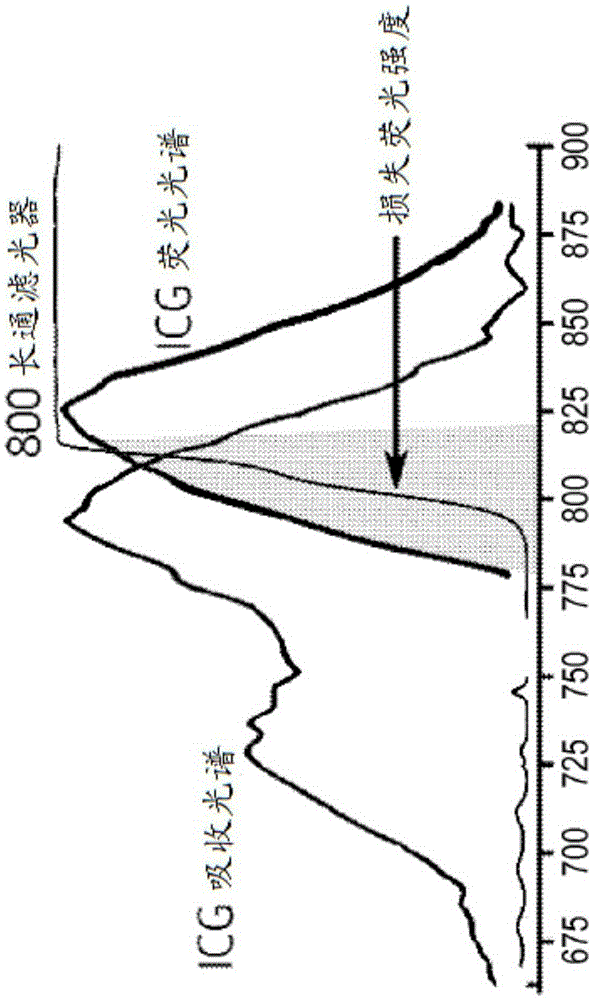Systems and methods for recording simultaneously visible light image and infrared light image from fluorophores
A visible-light, fluorophore-based technology for use in analysis, applications, diagnostic recording/measurement, etc. using fluorescence emission
- Summary
- Abstract
- Description
- Claims
- Application Information
AI Technical Summary
Problems solved by technology
Method used
Image
Examples
Embodiment 1
[0147] Charge-coupled device (CCD) or complementary metal-oxide-semiconductor (CMOS) sensors used in cameras have broad-spectrum sensitivity in the 400nm to 1000nm range ( figure 2 ). All red, green and blue sensors exhibit sensitivities in the wavelength range of 800-1000nm. Commercially available cameras have on top of the sensor such as image 3 The color filter array (CFA) or color filter mosaic (CFM) used to capture the color information of an image as shown in . In addition to this filter array there is an additional NIR short pass filter that cuts off light at wavelengths of 700-1000 nm.
Embodiment 2
[0149] We use the sensitivity of red, green and blue pixels in the near-infrared region (NIR) to detect infrared fluorescence. A visible light source illuminates the sample of interest. In addition, a laser is used as excitation light for infrared fluorophores in tissues, and the emitted light of infrared fluorophores is detected by a CCD camera. At the same time, the excitation light is filtered before reaching the CCD camera so as not to interfere with the detection of the emitted light. Image frames are captured when the laser is on (on frame). Another image frame is captured while the laser is off (off frame). Both visible light and infrared fluorescence are detected on the frame instead of only visible light on the frame. Thus, the difference in intensity between on-frame and off-frame provides information about the infrared fluorescence signal. ( Figure 4 ).
[0150] 1. To stimulate:
[0151] Excitation is achieved using a very narrow wavelength laser at the NIR ...
Embodiment 3
[0157] Fluorescence emitted by NIR fluorophores can be detected on all RGB channels by removing the NIR short-pass filter in front of the sensor ( figure 2 ). But in order to differentiate between visible and NIR light, we have to make sure that no visible light is present on the sensor when the NIR image frame is captured. In order to capture NIR light, no visible light should be present. In some cases, when no visible or NIR light is present, we capture a frame, record the light and then subtract that frame from the NIR captured frame. Clinical prototypes are shown in Image 6 middle.
[0158] 1. Filter combination:
[0159] We use very specific filter combinations to achieve the highest signal-to-noise ratio (SNR). Instead of using broadband excitation as described in most current NIR systems, we use extremely narrow band excitation at 785nm (optimal for ICG, can vary depending on the fluorophore), which is further narrowed using a laser-cleaned filter ( Figure 7 ),...
PUM
 Login to View More
Login to View More Abstract
Description
Claims
Application Information
 Login to View More
Login to View More - Generate Ideas
- Intellectual Property
- Life Sciences
- Materials
- Tech Scout
- Unparalleled Data Quality
- Higher Quality Content
- 60% Fewer Hallucinations
Browse by: Latest US Patents, China's latest patents, Technical Efficacy Thesaurus, Application Domain, Technology Topic, Popular Technical Reports.
© 2025 PatSnap. All rights reserved.Legal|Privacy policy|Modern Slavery Act Transparency Statement|Sitemap|About US| Contact US: help@patsnap.com



